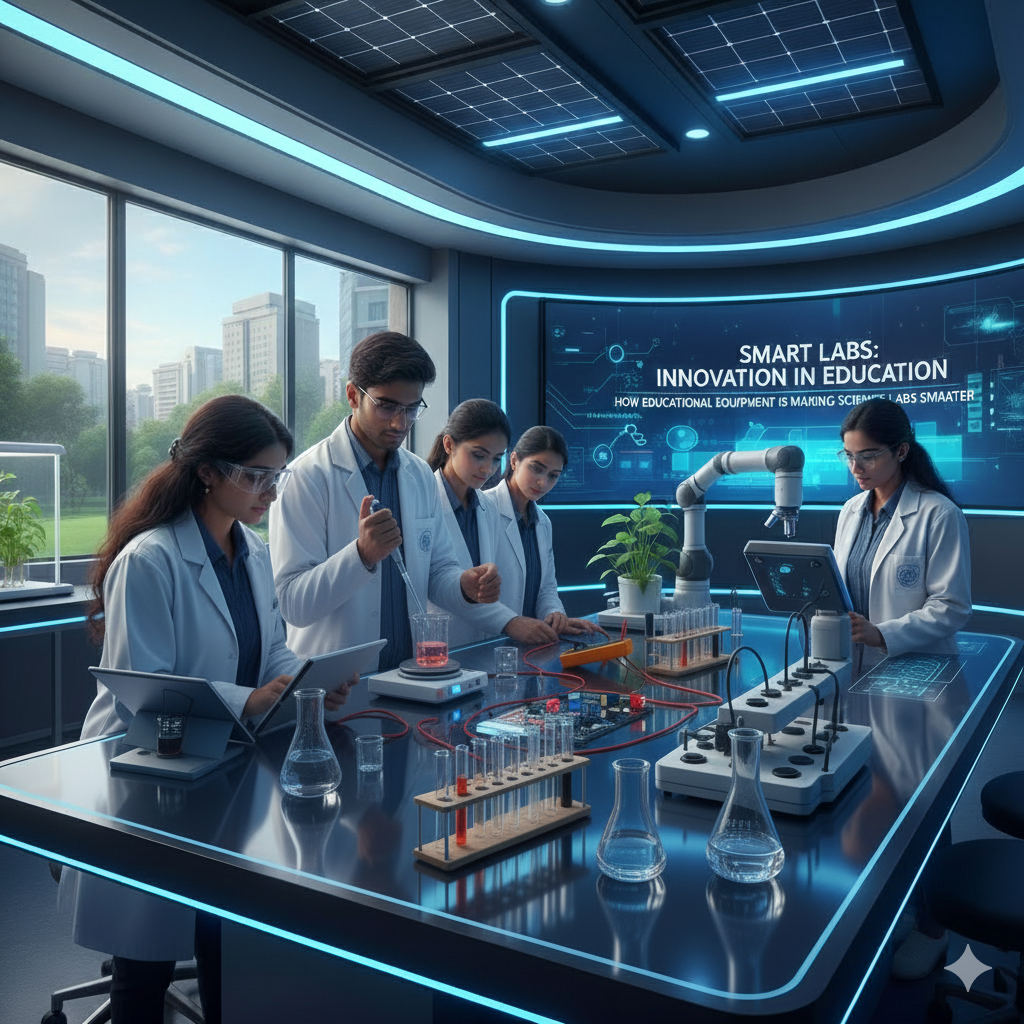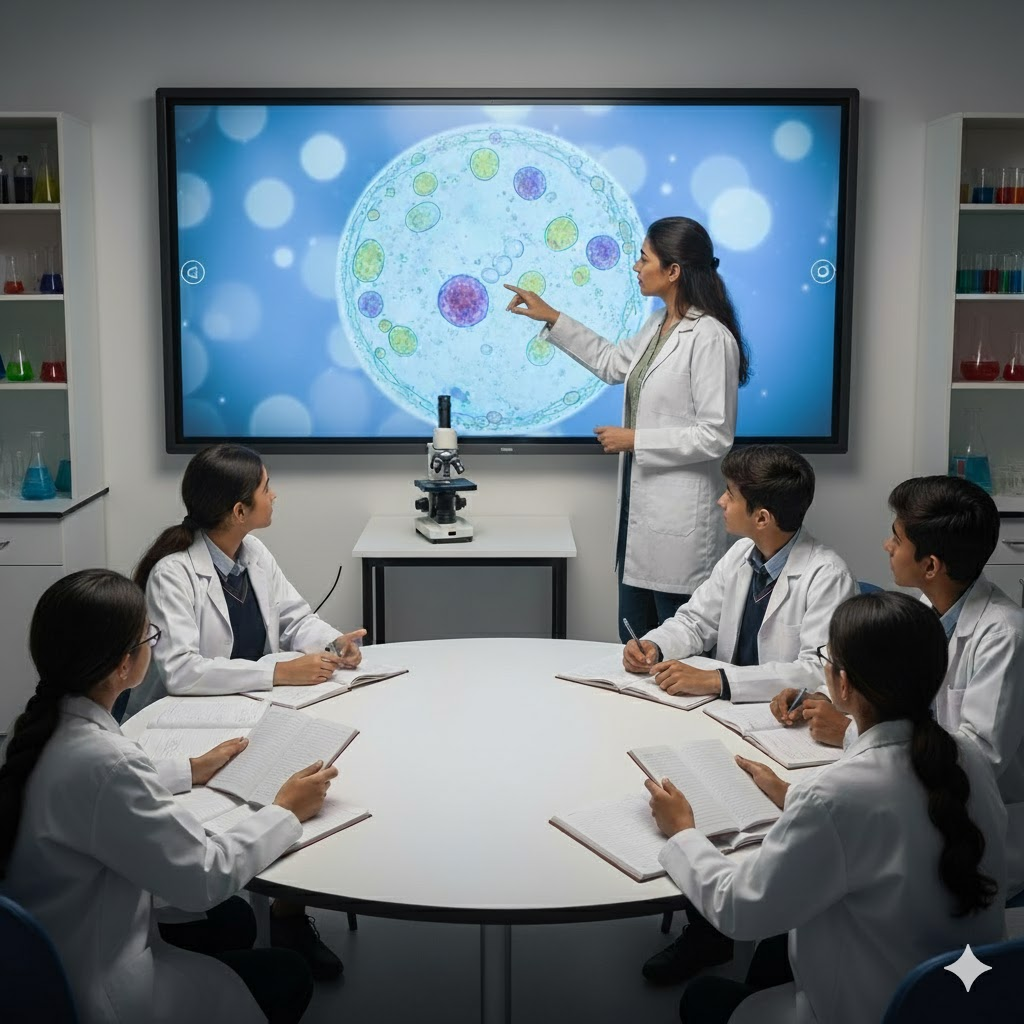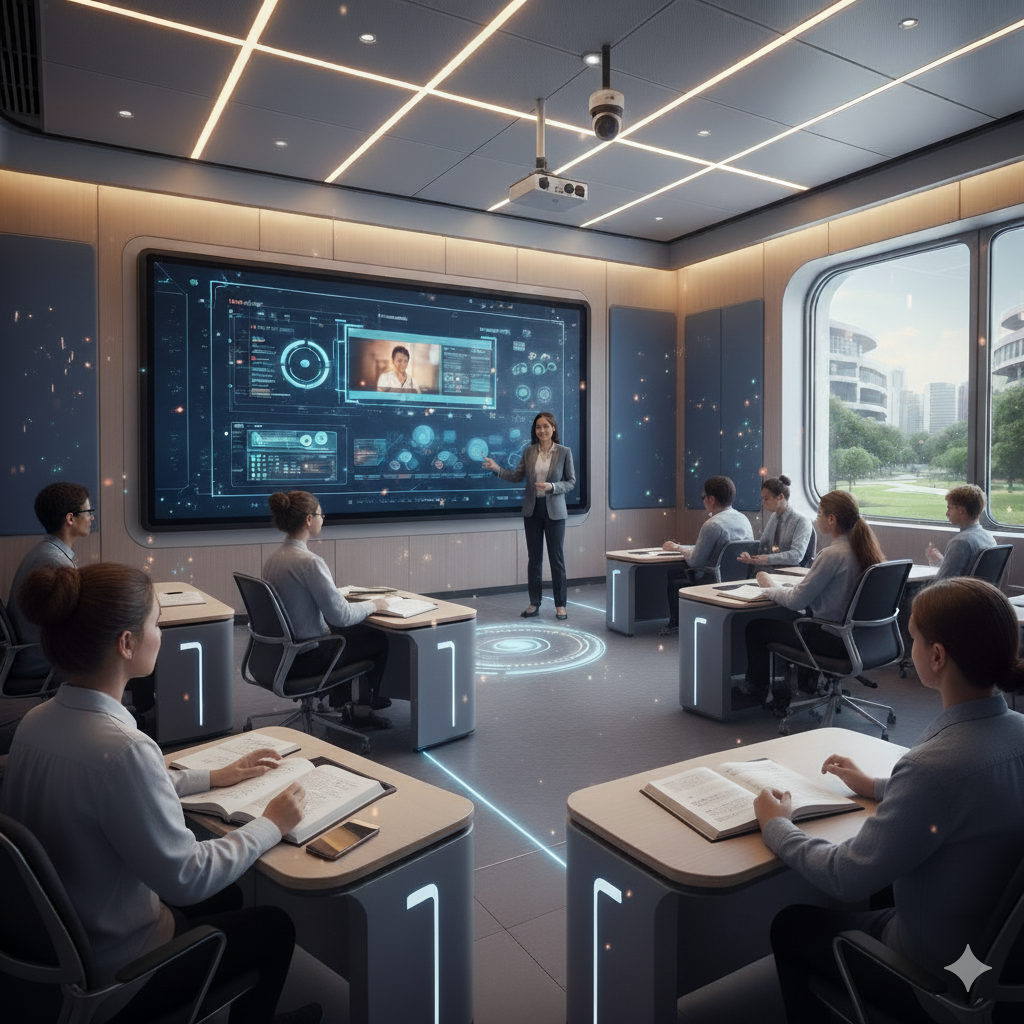How Educational Equipment is Making Science Labs Smarter

Remember the school science lab? For many, it evokes a distinct memory—the sharp smell of chemicals, the clink of glass beakers, and the focused quiet of students huddled over a Bunsen burner, meticulously recording observations in a notebook. That traditional, hands-on experience was the bedrock of science education for decades.
But in an era defined by data, connectivity, and interaction, that bedrock is evolving.
The modern science lab hasn't eliminated the hands-on component. It has supercharged it. Today, the most effective learning environments are blending physical experimentation with digital power. The conversation is shifting from what students are observing to how they are observing, capturing, and collaborating on that information.
This transformation is powered by a new generation of educational equipment designed not just for function, but for interaction, integration, and insight. For school leaders and educators in India, understanding this shift is key to building classrooms that don't just teach science, but allow students to experience it.
The New Face of the School Science Lab
The traditional lab, while foundational, often operated in static moments. Experiments were demonstrated at the front, or students worked in small groups to achieve a single, often delayed, result. The focus was on manual experiments and one-time demonstrations.
Today’s science labs are dynamic, data-rich ecosystems. They are designed to mirror how science is practiced in the real world—combining hands-on exploration with real-time data capture, visual collaboration, and a suite of connected devices. This is the new standard of smart classroom equipment.
When a student conducts an experiment today, they aren't just watching a liquid change colour. They are watching a probe send live data to an interactive display, tracking the chemical reaction as a visible graph. Students now experience experiments the way scientists do—through live visuals, instant feedback, and digital tools that record and annotate every step of the inquiry process.
Why Modern Educational Equipment Matters
Investing in new technology is about solving long-standing challenges in education: engagement, accessibility, and teacher efficiency. Modern educational equipment provides tangible benefits that ripple through the entire learning process.
- Better Engagement: The difference between passive observation and active participation is that an interactive system. When students can see results unfold in real-time, a graph forming, a microscopic image projected for all to see, a hypothesis confirmed or denied instantly, they are no longer just spectators. They become data analysts, and the "why" behind the "what" becomes crystal clear.
- Improved Accessibility: A one-size-fits-all lab is a barrier to learning. Large visual interactive displays ensure the student in the back row sees the same detail as the student in the front. Clear, high-fidelity audio and recording options ensure every learner, including those with hearing challenges or different learning paces, stays included.
- Consistent Learning: Complex concepts are rarely mastered in a single 40-minute session. Modern lab systems allow sessions to be recorded, shared, and revisited. This "learn, replay, reinforce" model is invaluable for reinforcing complex multi-step procedures, studying for exams, or helping students who were absent catch up.
- Integrated Workflows: Teachers are at their best when they are guiding inquiry. An integrated system, where the display, camera, audio, and software all work together, is crucial. Teachers spend less time managing multiple incompatible tools and more time facilitating discussion, asking probing questions, and guiding students toward discovery.
Key Categories of Educational Equipment for Modern Labs
When we talk about a "modern lab," we aren't talking about a single gadget. We are referring to an integrated ecosystem of tools. Here are the key categories that make the biggest impact.
1. Interactive Displays for Demonstrations

The modern blackboard is the interactive display. In a science lab, it becomes the command centre for learning. These large touch screens are where the digital and physical worlds merge. Teachers can use them to model complex experiments step-by-step, pulling in diagrams, videos, and live data feeds.
Crucially, integrated cameras and microphones allow the whole class to view close-up reactions clearly. Imagine a biology dissection: a high-definition camera can focus on the demonstration, projecting a crystal-clear image onto a 120-inch or 200-inch display for all to see. Students can then come to the screen, use a digital pen to annotate results, circle a specific artery, or highlight a reading directly on the display. It transforms passive observation into active, class-wide collaboration, making these interactive boards for classrooms a lab essential.
2. Smart Visualization and Data Tools

This is where the "data-driven" promise comes to life. Many labs now connect digital sensors or probes, for temperature, motion, pH, voltage, and more, that project real-time data directly onto the main screen.
The impact is profound. Instead of students dipping a litmus strip and recording a single, static pH value, they can now add a substance drop by drop and watch the pH graph change instantly. They see the exact moment a solution becomes acidic or alkaline. This direct visual relationship helps them grasp complex scientific relationships much faster and, just as importantly, teaches them how to interpret data visually—a critical skill for any future-ready student.
3. Lesson Recording and Replay
A demonstration of a complex physics principle or a multi-step chemistry experiment is dense with information. It's almost impossible for a student to capture every nuance. That's why lesson recording systems are valuable educational equipment. These systems let teachers capture the entire demonstration in full. This includes their audio explanation, the video feed of the experiment, and all the annotations made on the interactive display.
Edited versions or full recordings can be shared through the school's learning management system. This allows students to review complex steps at their own pace before an exam. It’s also a powerful tool for safety training (reviewing procedures) and for ensuring continuity when students miss a session.
4. Integrated Audio and Collaboration Equipment
In a noisy, active lab, clear communication is everything. Sensitive microphones and high-quality speakers ensure every question and every instruction is heard clearly, whether the teacher is at the front bench or helping a group at the back.
This audio-visual (AV) integration is also the key to breaking down the classroom walls. Remote learners, guest speakers, or even students in an overflow classroom can participate through life-size displays and shared virtual whiteboards. Schools with limited lab space or those participating in inter-school projects can give all students access to high-level demonstrations in real time.
5. Assessment and Reflection Tools
The lab session shouldn't end when the equipment is put away. The final, crucial step is linking the practical work to conceptual understanding. Some digital lab setups now bridge this gap by linking experiments to quick post-activity quizzes, polls, or digital observation sheets, often right on the interactive display.
Teachers can use this data to track performance patterns ("I see 60% of the class is confused about variable X") and adjust their teaching. For students, it provides immediate feedback, helping them identify where they need practice and solidifying the connection between their hands-on work and the scientific theory behind it.
Accessibility and Inclusion in Modern Labs
The single greatest promise of this new wave of educational equipment is the power to create a truly inclusive learning environment. A traditional lab can be challenging for students with physical, sensory, or cognitive differences.
Modern, adjustable setups, large-scale visuals on an interactive display, and clear, amplified audio make simple participation easier for all students. Captioning and transcription tools can be integrated, ensuring that lab discussions and teacher instructions are fully accessible to those with hearing challenges. Most importantly, the recording features provide a lifeline for students who need repetition, extra processing time, or a different way to review material, ensuring they can engage with the content on equal footing.
Building a Future-Ready Science Lab
For school administrators looking to make this transition, the path forward requires strategic planning.
- First, evaluate your foundation: Look at your existing space, power capacity, and network connectivity. Advanced smart classroom equipment is useless without reliable Wi-Fi.
- Choose interoperable systems. This is the most critical advice. Avoid the "patchwork" approach of buying a display from one brand, a camera from another, and software from a third. Choose interoperable, holistic digital classroom systems where the display, audio, computing, and collaboration tools are designed to work together as one unit.
- Focus on easy maintenance and minimal setup. The goal is teacher adoption. Prioritize solutions that are easy to use, boot up quickly, and don't require an IT degree so teachers can start lessons without friction.
- Prioritize safety and reliability. All educational equipment used in a classroom, especially a science lab, must be tested, certified, and built to withstand daily use.
The Takeaway
Modern educational equipment is fundamentally changing the science lab. It's transforming it from a room full of separate, analogue tools into a single, connected learning ecosystem.
When displays, audio, computing, and collaboration come together seamlessly, experimentation becomes more immersive, data becomes clearer, and learning feels more real. The future of science labs is about integrating the right gadgets so that every single student can see, hear, and understand science better than ever before.
Frequently Asked Questions
1. What are the key budget considerations for setting up a smart science lab in India?
When budgeting for a smart science lab in India, schools should look beyond the initial purchase price of the educational equipment. Key considerations include:
- Total Cost of Ownership (TCO): Factor in maintenance, software subscriptions, and future upgradeability.
- Teacher Training: Earmark funds for a comprehensive professional development program to ensure teachers can fully utilize the new smart classroom equipment.
- Section 12A/80G of the Income Tax Act, which many educational trusts are registered under, has specific compliance and documentation requirements for capital expenditure.
- Infrastructure: Account for necessary upgrades to electrical wiring, and high-speed internet connectivity.
- After-Sales Support: Prioritize vendors who offer strong, localized technical support within your city or region.
2. How important is teacher training for new smart classroom equipment?
Teacher training is the most critical factor for the success of any new technology investment. The most advanced educational equipment will go unused if educators are not confident in operating it. Effective adoption strategies must include:
- Hands-on Workshops: Initial training that goes beyond the basics and focuses on pedagogical use cases.
- Ongoing Support: A dedicated support person or system for troubleshooting.
- Resource Libraries: Access to pre-made lesson plans or templates that integrate the new interactive display and data tools.
- Peer Mentoring: Creating opportunities for tech-savvy teachers to share successes and best practices.
3. What security measures should schools consider for data-driven lab equipment?
As labs become data-driven, student privacy is paramount. When evaluating educational equipment that records sessions or tracks assessment data, schools must ask:
- Data Encryption: Is all data, both in transit and at rest, encrypted?
- Access Controls: Who has access to the data and recordings? How are permissions managed?
- Data Storage: Is the data stored on-premise or in the cloud? If cloud-based, where are the servers located, and what compliance standards (like GDPR or India's Digital Personal Data Protection Act) do they meet?
- Clear Policies: Does the vendor provide a clear, transparent privacy policy?
4. Does the best educational equipment differ for a physics lab versus a biology lab?
Yes. While a foundational platform like an interactive display and a lesson recording system are beneficial for all subjects, the specific data-collection tools will vary significantly.
- A biology lab might prioritize high-definition digital microscopes that can project images to the main screen.
- A physics lab will require a wide range of sensors for measuring motion, light, voltage, and sound.
- A chemistry lab would focus on probes for accurately tracking real-time data like temperature, pH, and gas pressure.
5. How can smart lab equipment support hybrid or remote learning for science classes?
This is a key advantage of an integrated system. Unlike a traditional lab, a smart lab can effectively include remote students. High-quality cameras capture the experiment, sensitive microphones pick up the teacher's explanation, and the interactive display acts as a shared hub. This allows students at home to:
- Watch live demonstrations in high-definition.
- See the real-time data from sensors as it appears on the display.
- Participate in discussions via the integrated audio system.
- Access the complete, recorded session (video, audio, and annotations) for review if they were in a different time zone or had connectivity issues.
Transforming your lab from a traditional space to a data-driven learning environment requires a reliable educational equipment partner. Explore Roombr's all-in-one digital classroom technology to see how you can empower better scientific inquiry and engagement.
Foziya Abuwala
Share
Step Into the future of
Education with Roombr

















